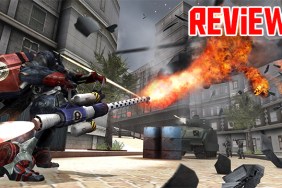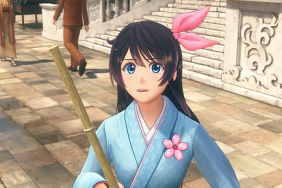Ai Love New York.
There’s a scene in the brilliant Age of Sail movie Master and Commander in which a young midshipman, aboard a Royal Navy frigate, ponders his admiration of two very different elders—a thin, bookish naturalist, and a beefy, rough-and-tumble ship captain. The boy muses: “Perhaps I could combine them, to be a sort of… fighting naturalist.” And sometimes it works – you jam together two or three things that aren’t usually combined, and what you get works… however odd it might appear to those who haven’t seen its like before.
[image1]Sakura Wars: So Long, My Love—the first of the Sakura Wars titles to be released outside Japan—is a bit like that. Is it an animé-flavored, dialogue-intensive, strictly-PS2-clunky-walkaround-like-it’s-the-first-Resident-Evil exploration game? Yes, indeed. Does it offer a brand of gridless, action-gauge-based combat roughly comparable to that found in Valkyria Chronicles… except in Crunchy, Japanese Cosplay/Bipedal Mech Mode, instead of Pastel Parallel-History, Pseudo-European Post-Steampunk? Sure it does—at least, in the final third of each game-chapter (more on this below). Does it have ‘dating-sim lite‘ elements, wherein players are obliged to—carefully and at their peril—feel out conversationally a cross-cultural bevy of attractive but easily-excitable females of questionable stability? Hel-LO? Japan?
Yes, Sakura Wars: So Long My Love has all of this—and lest you question the capacity of the Japanese to out-weird you at every turn, they’re going to throw in an ultra-secret, demon-fighting, global covert agency that keeps its workaday cover by putting on evening Broadway stage productions… complete with musical numbers to watch and enjoy.
The time is 1928, the place New York City. It seems that demonic beings are threatening the Big Apple; a special assault force equipped for their exorcism has been cobbled together, and young, decidedly-green adviser Shinji has been dispatched from Japan to deal with the operation in New York (which he has never visited before). Imagine his surprise when he learns that—in addition to heading up an elite, all-female group of mech pilots to combat the aforementioned demonic beings—he must also help out with the aforementioned stage productions, juggle the emotions and affections of a gaggle of fairly wiggy American girls (plus one Japanese), and simultaneously learn to cope with his new Japanese-transplant, urban life in the City That Never Sleeps, Even When Robo-Demons Are Attacking It.
[image2]Each of the game’s eight chapters is subdivided into three main modes of play: Interactive, for characters to ‘mingle’ and advance the main story—this is also where you’ll see how your Broadway stage shows and interpersonal relationships are doing; Adventure, to meet new characters, visit new neighborhoods (downtown hotel/shopping districts, Harlem, etc.), and investigate mysteries; and Battle, to combat enemy forces both on land and aerial environments (the players’ mechs can also transform into air-combat configurations).
Sakura Wars eschews the traditional, grid-based battle scheme in favor of a more fluid system based on Action Gauges. Action Gauges are composed of a certain number of bars, which can be spent (or not) to move, guard, heal, or attack. When the gauge is used up, that unit’s turn is over.
In addition, the various ‘mech-pilots in the squad can perform powerful cooperative combo attacks—the combined effectiveness of which depends not only on the strength of the interpersonal bonds between the various female pilots, but also on that between the pilots and Shinji himself. So it’s important for Shinji to keep the, um, girl-trouble to a minimum, in order to save the entire city from being devoured in a chaotic firestorm of robo-evil. So yeah, the game’s got some ultra-realistic aspects going for it, too.
Along the way, attention must be paid to the quality of the Broadway musical performances which the player must help stage and improve via scattered interactive mini-tasks, such as making sure the stage-lighting fuses don’t blow out during performances. Dialogue-based inquiries of the various characters, special-encounter side quests, and a ‘Cameratron’ picture-taking mini-game round out the many animé-inspired, story-driving cutscenes, all of which have dual (English/Japanese) voice-overs.
[image3]Be aware, however, that Sakura Wars is much less a tactical combat game—by virtual volume, if you will—than it is a sort of interactive story. Players will spend a large amount of their time watching simple 2D cutscenes and making point-of-view inquiries of the various characters, occasionally making some rudimentary dialogue-tree choices to get on the various NPCs’ good sides… or not.
In fact, you only really get around to the mech-based combat in the latter portion of each chapter, the battles (and satisfyingly-huge Boss-battles) therein acting as a sort of cathartic, tactical, dramatic cap-off reward for one’s progression into the overall story. It’s a little like chowing down through a bowlful of tasty cinnamon-flavored oatmeal to see (finally) the smiling bunny at the bottom of your bowl… except in this case, the ‘bunny’ is a deadly, bipedal mech armed with HE-tipped missiles and plasma-fans, and piloted by an easily-offended, cosplay-attired, mildly-psychotic animé chick with her dainty, less-than-entirely-stable finger on the button (and your tactical survival hinging on her cooperative faculties). Enjoy!
Thankfully, Sakura Wars also devotes a generous amount of its story and dialogue to humor, and even to making some genuinely insightful (and in some cases refreshingly blunt) comments on what it means to be American and what it means to be Japanese amidst preconceived notions of both… and sometimes, on how stereotypes exist for a reason.
CAVEAT EMPTOR: This is a PS2-gen game through and through, and it unapologetically looks and feels like it. The vast-majority abundance of minimally-animated character-portrait conversations, the wordy mid-fight orations, the clunky mechanics of walking/running around various New York neighborhoods—if you’re a next-gen visuals/presentation snob, all these things will probably make your head want to go all Scanners on you. But for players of a more old-school bent who like to steep themselves in the story and the character interaction, Sakura Wars is an unusual Neopolitan ice-cream serving of animé presentation, quirky Japanese-brand interpersonal humor, and a little old-fashioned mech-butt kicking for good measure.
-
Unique tri-style mash-up of genres
-
Animé movie-scenes in dual voice-overs
-
Character-bond 'branching', multiple endings
-
Pokes fun at ethnic stereotypes
-
Mech combat, only in chapter-end spurts
-
Female scheme a little <i>too</i> much like reality
-
Long patches of "hit the button to continue"
-
PS2 game largely <i>looks</i> like one
-
Dialogue can sometimes d-r-a-g on











